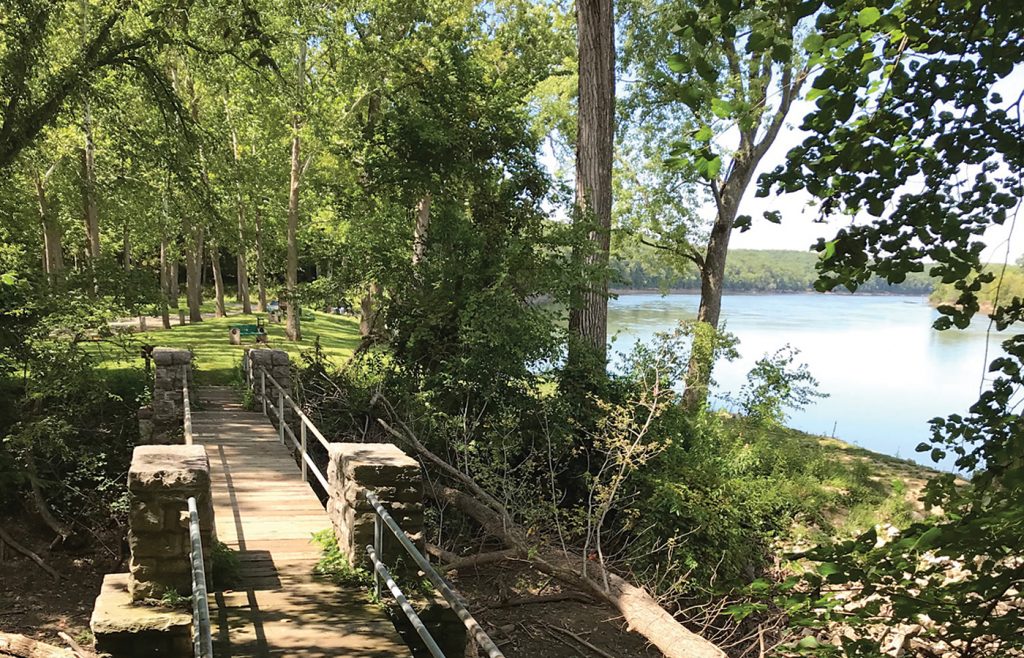
Last March, as spring was barely springing, I began my quest for water. April and May were about to bring a veritable deluge to our state, sure, but down in Southeast Iowa, by June I typically start to feel a little landlocked. I decided it would be prudent to have a back-pocket treasury of trails with an H2O view. Waterside walks, if you will.
Green and, yes, even brown stuff can be lovely on a hike, but the sights and sounds of water just make everything better. Those gushing, rushing, dripping, and dipping melodies are soothing to the soul. And if it’s a spectacular enough show, I might even forget for a minute that I don’t own a beach house anywhere. Yet.
Let’s go for a stroll.
Rocks, Hawks, and Hepatica
Feeling “Driftless?” Head north and then east to explore one of the few Iowa regions the glaciers didn’t quite get around to scraping flat. No offense to the more gently sloping parts of our state, but the dramatic ups and downs of Iowa’s northeast corner make for some voluptuous terrain and more dramatic water features than you’d expect from our country’s 13th flattest state.
“This entire Driftless region is just crawling with parks and trails,” my Anamosa friend Tim Fay boasted, so I figured I’d better get my butt up there.
You want spectacular? Head to the Whitewater Canyon Wildlife Area just outside of Cascade—right where Jones, Jackson, and Dubuque counties all smoosh into each other. It’ll take a drive. And you may get lost. We did. But it’s an area that isn’t awful to get lost in.
My motating companion and I deserted our car to explore two routes within the conservation area, an expanse that boasts old-growth forest, prairie-plant communities, unusual geologic features (including 13 caves), and restorative, replenishing views of Whitewater Creek, nestled deep inside an honest-to-goodness canyon.
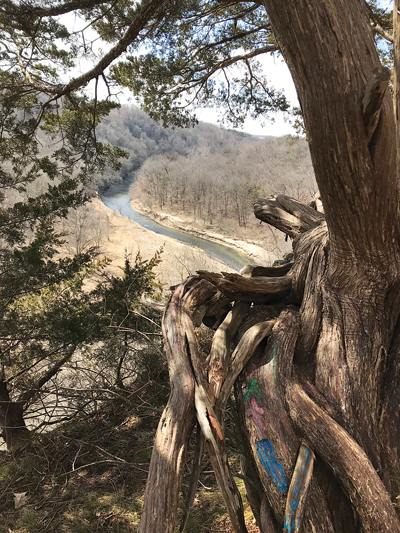
After a wind-whipping hilltop hike alongside golden prairie grasses dotted with tiny birds perched on winter’s tallest remaining stalks, we bore right at the first fork to head northwest down Streambottom Trail, a promisingly steep path that zigzagged through trees and bluffs toward our first watery view. The trail spit us out onto an inviting sandbar peppered with colorful rocks, from which we could watch the tumbling waters of the creek take a sharp turn away from us. Two benches along the bank held the space for lazy ponderings and deepish thoughts. Because that’s what you do in the presence of churning, sparkling water dancing around a path of pretty stones.
The only thing missing was a good cheese sandwich.
“In the height of the season, this place is crawling with Boy Scouts in canoes,” remarked Tim, only slightly begrudgingly. Indeed, that day I was happy for the brisk air and the solitude.
It was only March. The water was still ice cold. But I stuck a toe in anyway.
Up top again at the fork, the second route kept us on higher ground heading true west into forested terrain (amenable to a quick pee behind a tree) and down a gently sloping path enforced every few yards with a wooden stair. A few steep steps up again brought us out onto a shady ledge overlooking the big kahuna.
Whitewater Creek snaked below us, peeking through a sea of feathery cedars and the skeletons of white-barked sycamore in the far distance. The gnarled roots of an oft-visited conifer, tagged with bright paint and the etchings of high-school sweethearts, offered a perfect perch for taking in the stunning panorama.
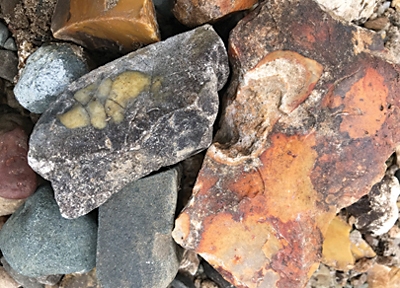
Too early yet for new growth to take hold, the barren vista offered greys upon silvers upon greys—and a less encumbered view through the branches at the water and rock far, far below.
“Bet you didn’t think you could find a view like this in Iowa, huh?” Tim grinned.
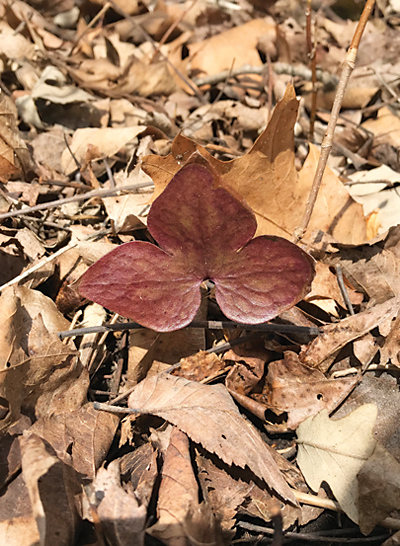
The trail split off to the south a ways, following the cliff’s curve, where we stopped to lean over the edge a few more times and gawk at the canyon and the water, seemingly miles below. As the morning’s clouds finally parted above us, Whitewater Creek—much grander than the word “creek” could ever convey—was turning a soft shade of aqua before our eyes. Hawks circled overhead. And underfoot, a first sighting of spring: the purplish triple-tipped leaf of a hepatica flower dared to greet us through last autumn’s fallen leaves.
Whitewater Canyon Wildlife Area is accessible from Highway 151 and Curoe Road, five miles northeast of Cascade. Find more info and a map at MyCountyParks.com.
Floost Fish at Ely Ford
Heading south to my favorite trail in Lacey-Keosauqua State Park always makes me think of my niece, Brynn.
As to be expected, there are words that crop up in a very young person’s vernacular that don’t quite register to the adult ear. There was a period, for instance, when any time someone would say the word “bank,” little Brynn would follow up with an excited response: “Floost!”
Floost? The word had her mother puzzled for months. What’s a floost? We hoped eventually the mystery would be revealed.
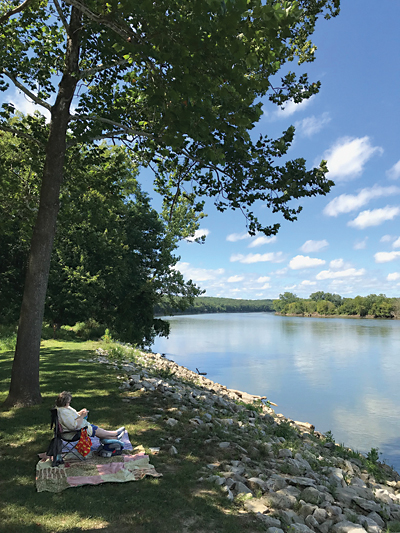
One breezy, gorgeous day, we womenfolk (my oldest niece, my mom, and my sister) packed up a picnic and cruised down Highway 1 to our favorite knitting spot—possibly my favorite spot in Iowa. The picnic area at Ely Ford offers that perfect mix of shade and sun, vast views of lazy currents and shiny Des Moines River sandbars, a grassy area for lawn games if you please, and charcoal grills if your lunch isn’t quite cooked yet, plus bridges, trail access in two directions, and even some fishing.
After arranging our lawn chairs to face out over the water (and retrieving our respective fiber projects), we sat listening to the lazy river and the rustling leaves overhead. Another sound emerged.
A clumsy school of fish was loitering below us, just a few feet beyond the steep, rocky riverbank. With their huge mouths clumsily sucking river foam from the top of the water, every few minutes the fish would take a collective dive below the surface, creating a rushing, gulping sound, best described as . . . floost! We laughed at the floost fish for hours as we wasted the afternoon away.
Ironically, the school of carp (?) we came upon did associate themselves with a “bank,” but later on, the truth about “floost” was revealed: Brynn had merely been practicing the word “florist,” a word which, in a kids’ video about “things you see downtown,” was introduced right after the word “bank.”
In March and again in August, I revisited the hiking trail that runs east and west from Ely Ford and can be picked up at various places throughout the park. Heading west, the trail followed hilly ups and downs as it meandered above the lazy river’s edge. I stepped off the path to explore various shelters and lodges (beautifully designed and equipped with functional fireplaces I plan to take advantage of later). I also recommend taking a look at the historical display at the northwest entrance, which describes in detail the park’s creation by the Civilian Conservation Core in the 1930s. And although I didn’t see them on my walk, there are 19 Indian mounds from the Woodland period at this end of the park as well.
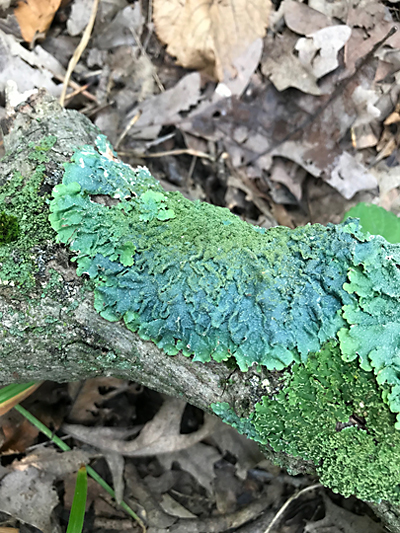
On the day I explored the trail heading east from Ely Ford, the woods were quiet and the path satisfyingly crooked as it navigated bridges, rocky outcrops, and various watery outlets trickling down into the wide river. Through the timber I spotted a bald eagle crossing silently over the water, and couldn’t help taking pictures of the bluest fungi I’d ever seen on a forest floor.
Views across the river are of farm and field, so above gurgling water sounds and softly rustling leaves, you can expect to hear a moo or two. It’s all part of the charm.
I heart Ely Ford.
Stay tuned for Waterside Walks: Part II, coming in spring 2020.
